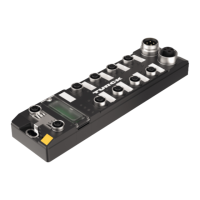V02.00 | 2019/10
137
Use Case 1: Parameterizing the Device Using e.g. a DTM
ü The IO-Link device is already installed in the system and connected to the master.
Parameterizing the device via DTM.
ð DS_UPLOAD_FLAG = 1, parameter set in the device changed.
a The parameter data are transferred from the new IO-Link device to the IO-Link master.
Fig.63: Data storage mode activated – parameter set in the device changed
Use case 2: replace a defective device with a device in the delivery state.
ü The new IO-Link device has not been connected to the master before.
The parameters of the new device remain unchanged, DS_UPLOAD_FLAG = 0.
a The parameter data of the defective device are transferred from the IO-Link master to the
new IO-Link device.
Fig.64: Data storage mode activated – parameter set in the device unchanged
Use case 3: replace a defective device with a device with unknown (changed) parameters
ü The new IO-Link device has not been connected to the master before.
The parameters of the new device remain unchanged, DS_UPLOAD_FLAG = 1.
a The parameter data are transferred from the new IO-Link device to the IO-Link master.
Fig.65: Data storage mode activated – parameter set in the device changed
NOTE
If device replacement is necessary when data storage is activated, an IO-Link re-
placement device with unknown parameter data should be reset to its factory set-
tings before connection to the IO-Link master.
Turck IO-Link devices can be reset to factory settings via a system command using a
generic IO-Link-DTM and the device-specific IODD. For the reset of third party
devices, please read the corresponding manufacturer documentation.

